Elevators, lifting platforms and hoists are sometimes referred to as handicap elevators. They are an alternative to the stair lift, preferred by wheelchair users or people looking for a lot of comfort. All solutions have in common the fact that the height difference is overcome directly in the vertical and not with the staircase.
Stairs can become a major obstacle for people who have limited mobility. There are aids, such as stair lifts, which are designed to take the terror out of these obstacles. However, wheelchair users or people looking for more comfort prefer a handicap lift. This usually refers to three different types of construction: Elevators, lifting platforms and hoists.
Prices and costs
A handicap lift allows older people to enjoy a new lease on life. The initial cost depends on many different factors, so depending on the equipment and customization, the lift can be significantly cheaper or more expensive than previously thought.
Factors affecting price
The cost of a handicap lift is made up of many different factors. Here it depends among other things on which model one decides, which drive is needed and which additional equipment the lift should have. Furthermore, the price is also calculated according to the height to be overcome and the load capacity. In addition, the lift must be adapted to the structural and personal situation of the customer. Basically, therefore, a lift for the disabled is in most cases a custom-made product. So, in summary, the following factors further drive up the overall price:
No. | Cost factors |
|---|---|
| 1. | Complexity and angle of inclination of the stairs |
| 2. | Number of steps |
| 3. | Effort during installation |
| 4. | Height to overcome |
| 5. | Additional equipment and optics |
| 6. | Weather resistance for outdoor installation |
| 7. | Load-bearing capacity and load-bearing capacity |
| 8. | Drive speed |
| 9. | Number of stops |
| 10. | Type of drive (electric motor, traction drive, rack and pinion drive / gear drive) |
The above factors thus ensure that manufacturers generally can not give a blanket price information. At the current time, the average price range for a disabled lift over one floor is around 5,000 to 10,000 €. Used models are already available for less than 3,000 €, but it is important to pay close attention to whether the model is suitable at all. When buying a new handicapped lift, a manufacturer can only provide a cost estimate after an on-site inspection. In addition, you should consider in advance whether the handicapped lift must also have special or adapted equipment. In this way, the manufacturer can prepare an offer perfectly tailored to your needs.
Acquisition costs
A handicapped lift allows barrier-free access often without extensive remodeling of the living environment. It can be installed within a very short time and is cheaper to purchase than conventional elevators. When buying a handicapped lift, you should expect to pay at least 5,000 €. These prices are standard market prices and do not refer to a single manufacturer. In the case of a single-family house with 1 floor and larger conversion costs, prices of up to 10,000 € can quickly arise. If the disabled lift is installed for a wheelchair user, up to 4,000 € subsidy can be applied for and claimed from the care insurance, if a corresponding care degree is available.
 Source: Shchipkova Elena / Shutterstock
Source: Shchipkova Elena / ShutterstockThe price of a handicap lift depends on various factors such as load capacity, travel speed, number of stopping points, height, type of drive, model and appearance. Disabled lifts for outdoor use are understandably more expensive than those for indoor use. The real purchase costs can be determined very accurately by obtaining several cost estimates from different lift manufacturers -and service providers.
An incalculable size remains however the costs of the necessary rebuilding measures at the single family house. If larger excavations are necessary at the single-family dwelling, additional costs can develop. Therefore, before buying a handicapped lift, find out about “all” the costs and financial subsidies involved. In addition to the care cost subsidy for measures to improve the individual living environment, the state-subsidized KfW Bank promotes measures to reduce barriers with favorable loans of up to 50,000 €.
Lift type | Stair form | Area | Price |
|---|---|---|---|
| Stairlift | straight stairs | Inside | 3,800 to 9,700 € |
| Stairlift | curved stairs | Inside | 8,000 to 15,000 € |
| Stairlift | straight stairs | Outside | 4,000 to 7,500 € |
| Platformlift | straight stairs | Inside | 9,000 to 15,000 € |
| Platformlift | curved stairs | Inside | 12,000 to 25,000 € |
| Platformlift | straight stairs | Outside | 9,000 to 15,000 € |
| Platformlift | curved stairs | Outside | 15,000 to 25,000 € |
| Lifting Platform | Height up to 1.79m | Outside | 8,000 to 15,000 € |
| Lifting Platform | Height up to 3m | Outside | from 17,500 € |
Prices and customization options vary widely from manufacturer to manufacturer. Flat price quotations such as a price per 1 meter height or per stair step do not exist. In general, you can say that the more steps are overcome and the more weight it must transport, the more expensive it is. For each additional meter, you should expect to pay at least 2,000 € more, not including conversion costs. A handicapped lift that is attached to the outside staircase, has a rail length of around 2 meters, has 2 stopping points, moves via a hydraulic drive and can be used by a wheelchair user should cost at least 8,000 € including installation. The purchase is cost-intensive and should be carefully planned. With a price comparison over welcher-Behindertenlift.de much money can be saved. You will receive up to three free and non-binding offers from handicapped lift providers from your region with an inquiry, which you can compare at your leisure and without risk.
Costs for maintenance and servicing
Disabled lifts are low-emission, durable, lightweight and space-saving. A handicap lift only needs to have its oil and seals changed every 5 years. The material required for this is freely available and costs around 100 €. For the professional implementation of the oil -and seal change, one should expect costs of about 500 €. The cost of labor for maintenance is about 1,000 €. As a rule, a partial or full maintenance contract is concluded with the lift manufacturer from whom the lift is purchased to cover maintenance for a period of five or ten years. The costs for maintenance, inspection, cleaning, lubrication, adjustment work and the replacement of wear parts are then usually regulated on a flat-rate basis.
Energy costs
The energy costs for a handicapped lift are made up of consumption during trips and standby times. For a disabled lift in a single-family house with 1,500 trips per year, i.e. approximately 4 trips per day, one should expect energy costs of 200 kWh standby power and 100 kWh travel power. At an electricity price of 0.26 €/kWh, this results in annual costs of approx. 78 €. Platform lifts in single-family homes stand still 99% of the time.
The energy costs therefore depend primarily on how much the elevator is used, whether the drive installed is suitable for the particular usage situation and what height the handicapped lift has to climb. As a rule, more than 50 % of the power consumption of handicapped lifts is consumed in standby (idle) mode. To save energy costs, you should make sure when buying that LED lamps are installed instead of halogen or incandescent lamps and that there is a timer function for lighting and electronics.
Rent or pay in installments
Many manufacturers also offer the possibility to rent the handicapped lift or to pay it off monthly by installments. Here it is advisable to compare the prices of the different offerers in detail and in peace with one another – that saves cash money. Furthermore, it can’t hurt to talk to your bank advisor about a financing model. In some cases, a bank loan may have lower interest rates than a loan through the respective lift manufacturer. In addition, an on-site inspection and estimate should be non-binding and free of charge.
Handicapped accessible elevators
Elevators correspond in their function to a normal lift or elevator. As a handicapped lift, they are usually retrofitted into a building. An example of this is the DomusLift. Its installation is relatively simple and therefore can be done within a short time. Since a normal 220V socket is sufficient for operation, no new electrical cables need to be laid. In addition, the space required by such a personal elevator is particularly small. Therefore, the footprint is particularly compact and the control system or mechanics also takes up hardly any space.
 Source: kfw.de | KfW-Bildarchiv | Fotograf: Thomas Klewar
Source: kfw.de | KfW-Bildarchiv | Fotograf: Thomas KlewarA vertical elevator can be used as a pedestrian or even with a wheelchair. Moreover, since the load capacity is very high (usually more than 250 kg), smaller loads can also be moved. Such a personal lift can be installed both indoors and outdoors. A shaft is not required. There are closed and open designs, which, of course, differ in price. Legal requirements that apply to the operation of a normal elevator do not normally apply to an elevator for the disabled.
A vertical elevator for the disabled can be used for one floor as well as for several floors. Due to the small space requirement, a solution can almost always be found. In the outdoor area, for example, a new access can also be created via an existing balcony. As a rule, a masonry shaft can always be dispensed with. Nevertheless, such lifts for the disabled are always custom-made. Second-hand trade, as is usual for stair lifts, for example, therefore hardly ever takes place.
Rental offers, which are also frequently offered for stair lifts, do not normally exist either. The costs associated with the installation of a vertical elevator are therefore high. Prices start at around 15,000 €. However, they are very much dependent on the structural requirements and the individual needs of the user. However, vertical elevators as handicapped elevators are not only found in private houses and apartments, but also in public buildings, companies or hospitals.
Platform Lifts and hoists for handicapped people
More affordable than vertical elevators are lifting platforms and hoists. They are mostly chosen by wheelchair users. Lifting Platforms and Hoists provide a straight platform that can be easily accessed by a wheelchair. In some cases, small ramps are required that can be used as a safety feature during travel. Many suppliers also offer their handicap lifts with an integrated folding seat so that the lift can be used by people who do not rely on a wheelchair.
Aerial lifts and hoists can be used indoors and outdoors. Usually, they have an open design and are therefore less protected and comfortable than a regular elevator or vertical elevator. Lifting Platforms and Hoists as handicapped lifts are primarily suitable for overcoming short stairs, for example in front of or in the entrance area of a house. Due to their high load capacity, they can also move smaller loads (such as a baby carriage or a week’s shopping).
Lifting devices and lifting platforms can only overcome short distances. They are not suitable for longer stairs. Therefore, for stairs that cover an entire floor or several floors, you must resort to another alternative. The prices of lifting platforms and aerial lifts are significantly higher than Stairlifts, but are roughly on par with a platform lift. Prices therefore start at just under 9,000 €, depending on the height to be climbed and the technical equipment.
Aerial lifts and lifting platforms are relatively quick to assemble, require little floor space and usually no structural modifications. There are models that do not need to be permanently mounted at all. This gives the opportunity to buy used or rent lifting platforms and hoists. This can reduce the cost of such a handicap lift by up to 50 percent.
Classical stairlifts as an alternative
An alternative to the handicap lift is the classic stair lift. People who are not dependent on a wheelchair usually choose a seat lift. Wheelchair users prefer a platform lift. Unlike handicapped lifts, the difference in height is overcome as the stairs rise. Seat lifts and platform lifts are therefore mounted directly on the stairs. Prices start at just under 4,000 € for a seat lift and around 8,000 € for a platform lift. Stairlifts for curved stairs, however, are significantly more expensive.

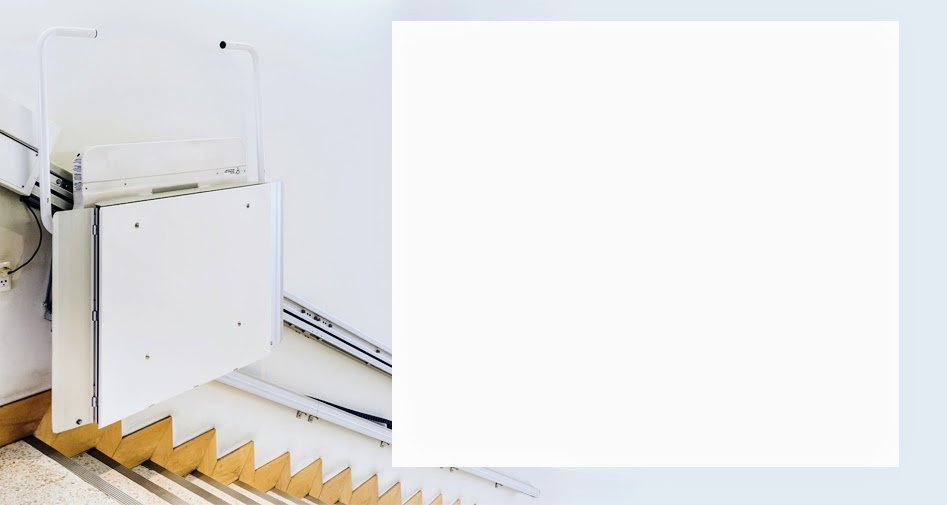
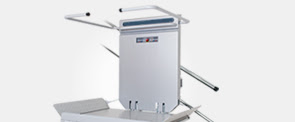
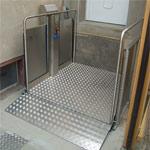
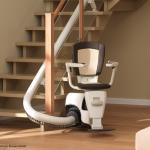
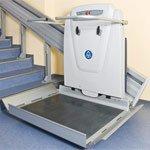

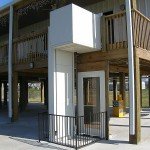

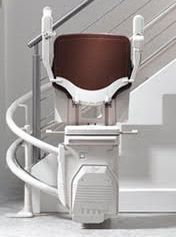
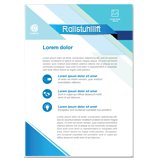

Good day, I need a lift to overcome a height of 2.50 m for a wheelchair user. As I can see from your comments, you also sell used hoists. Please send me an offer. Thank you in advance for your effort.
With kind regards
Anette Reimringer
Dear Sir or Madam,
I am interested in a used vertical lift. It should be able to lift a handicapped person sitting on a chair to a height of about 5.20 m. For me, the lifting mechanism alone is enough, because we can build the shaft ourselves. The lift is to be used indoors. Please write me if you also offer used lifts or maybe you know another supplier who could help me. I would be glad to receive some offers. I am currently abroad, so I am not available by phone this week.
With kind regards.
Robert Land